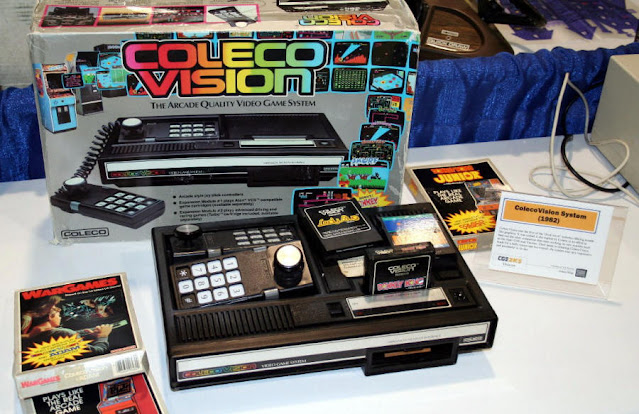The ColecoVision, a home video game console released by Connecticut Leather Company (Coleco) in 1982, stands as a significant milestone in the gaming industry. Known for its superior graphics, extensive game library, and innovative hardware, the ColecoVision offered a gaming experience that was ahead of its time. This article delves into the history, features, impact, and legacy of the ColecoVision, highlighting its role in shaping the gaming industry.
The Birth of ColecoVision
Company Background
Coleco, originally a leather company, diversified into electronics and toys in the 1960s and 1970s.
- Previous Ventures: Before ColecoVision, Coleco had success with the Telstar series of consoles, which were based on General Instrument's "Pong-on-a-chip" technology. However, the company aimed to create a more advanced gaming system to compete with Atari and Mattel.
Development and Release
The ColecoVision was developed to offer arcade-quality graphics and gameplay in a home console.
- Launch: Released in August 1982, the ColecoVision was priced competitively and included the arcade hit "Donkey Kong" as a pack-in game, which significantly boosted its appeal.
Technical Specifications and Features
Hardware Capabilities
The ColecoVision was renowned for its impressive hardware, which set it apart from its contemporaries.
- Processor: It was powered by a Zilog Z80A microprocessor, running at 3.58 MHz, which was quite powerful for its time.
- Graphics and Sound: The console featured a Texas Instruments TMS9918A video display processor, capable of displaying 32 sprites, and up to 16 colors simultaneously. Its sound capabilities were provided by a Texas Instruments SN76489A sound chip, offering three square wave channels and one noise channel.
Controllers and Accessories
The ColecoVision's controllers and accessories added to its appeal.
- Standard Controllers: The console came with two wired controllers featuring a numeric keypad, a joystick, and a pair of side buttons. This design allowed for a wide range of input options.
- Expansion Modules: ColecoVision offered various expansion modules, including the Expansion Module #1, which allowed users to play Atari 2600 games, significantly increasing the console's game library.
Game Library
Arcade Ports and Original Titles
The ColecoVision is best known for its high-quality arcade ports and original titles.
- Arcade Quality: Games like "Donkey Kong," "Zaxxon," and "Time Pilot" demonstrated the console's ability to deliver arcade-quality graphics and gameplay at home. This was a significant draw for gamers who wanted to experience their favorite arcade games without leaving the house.
- Diverse Genres: The game library covered a wide range of genres, including action, sports, puzzle, and strategy games. Notable titles included "Turbo," "Smurf: Rescue in Gargamel's Castle," and "Carnival."
Third-Party Support
Strong third-party support was crucial to the ColecoVision's success.
- Licensed Titles: Coleco secured licenses from major arcade game developers, ensuring a steady stream of popular titles. This strategy helped the console stand out in a crowded market.
- Developer-Friendly: The console's architecture made it relatively easy for developers to port their arcade games to the ColecoVision, encouraging more titles to be released.
Market Impact and Competition
Sales and Popularity
The ColecoVision was well-received upon release and enjoyed strong sales.
- Initial Success: By Christmas 1982, Coleco had sold over 500,000 units, and the console's popularity continued to grow throughout 1983. It quickly became one of the best-selling consoles of its time.
- Competitive Edge: The superior graphics and arcade-quality games gave the ColecoVision an edge over competitors like the Atari 2600 and Intellivision.
Challenges and Decline
Despite its initial success, the ColecoVision faced several challenges.
- Video Game Crash of 1983: The North American video game crash of 1983 severely impacted the industry, leading to a significant decline in sales for all consoles, including the ColecoVision.
- Market Saturation: The rapid saturation of the market with numerous consoles and low-quality games contributed to the decline. ColecoVision was not immune to these broader industry trends.
Legacy and Influence
Technological Influence
The ColecoVision's technological innovations left a lasting impact on the industry.
- Graphical Standards: The high graphical standards set by the ColecoVision influenced future console designs. It demonstrated that home consoles could offer arcade-quality experiences, setting a benchmark for subsequent generations.
- Modular Design: The concept of expansion modules, which allowed for additional functionality, influenced future console designs that embraced modularity and backward compatibility.
Collector's Item
Today, the ColecoVision is a prized item among retro gaming enthusiasts and collectors.
- Rarity and Value: The console and its games are considered valuable collector's items, often fetching high prices on the secondary market. The nostalgia and historical significance of the ColecoVision contribute to its enduring appeal.
- Homebrew and Community Support: The ColecoVision has a dedicated community of fans and developers who continue to create homebrew games and hardware, keeping the legacy of the console alive.
Revival Efforts
There have been several attempts to revive the ColecoVision brand.
- Flashback Consoles: In recent years, "plug-and-play" versions of the ColecoVision, known as ColecoVision Flashback, have been released. These consoles come pre-loaded with classic games and aim to capture the nostalgia of the original console.
- Emulation and Digital Releases: Many ColecoVision games are available through emulation and digital platforms, allowing new generations of gamers to experience the console's classic titles.
Conclusion
The ColecoVision stands as a significant chapter in the history of the gaming industry. Its advanced hardware, impressive game library, and innovative features set it apart from its contemporaries and left a lasting legacy that continues to influence the gaming landscape today. Despite facing challenges and an untimely decline due to the video game crash of 1983, the ColecoVision remains a beloved and respected console among gamers and collectors. Its story is a testament to the impact that innovation and quality can have on the gaming industry, shaping the experiences and expectations of gamers for generations to come.


